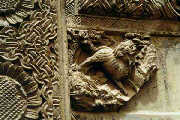When talking about sculptures, people will most likely think of the ancient Roman architectural sculptures or the Greek nude sculptures; few are acquainted with the history or characteristics of Chinese sculpture. In fact, Chinese sculptural art, while differing greatly from its western counterparts, has thrived in a long historical process of development in many aspects.
Chinese sculptors have sculpted delicate objects, such as figures, animals, plants and landscapes, with a number of new kinds of raw materials, such as sand and coal, apart from the traditionalbronzeandjade. Many of the works have become precious artistic pearls in the treasure house of Chinese art.

Reliefs are a form of sculpting where pictures are chiseled into the surface of brick or stone to create something that resembles a combination of both painting and reliefs. This particular art form was used in ancestral halls and tombs as architectural decorations, although most are found on brick walls in tombs.

Coal carving, which has existed for thousands of years but was only known by a few, has made a comeback with its vitality.

By piling, digging, carving and hollowing out this common element, turning it into mythical scenes and fairytale figures, sand sculptors have turned the art of carving in sand into a new trend in many big cities. Known as a modern art for only 20 years, sand sculpting is a popular and recreational art capable of drawing widespread attention from the public.

Molding human figures and animals from clay or glutinous rice flour is a popular folk art in both urban and rural areas in China.

Offerings molded from butter, or butter sculptures, are central to spiritual development in Tibetan Buddhism. As a unique sculptural art in Tibetan culture, the art has an origin in Tibetan Bon religion and is considered one of the exotic flowers in the treasury of Tibetan art.
Author: Jessie










